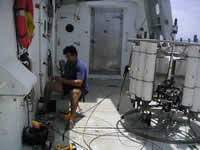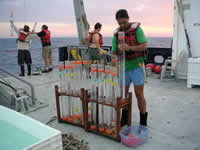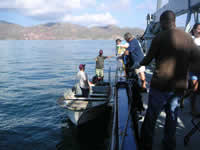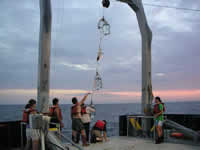


|
The Project Part 1: Part 2: Part 3:
|
02 August, 2005
|
 Rob repairing the CTD  Sediment traps  Delivery of fresh fruit and vegetables in Guaymas  Pulling in the array at dawn, 8/2 |
We got up at 3:30 in the morning to take more water samples and to pull in the array. By 6:15 we are leaving the northern part of the Gulf and are heading back to Guaymas, where we’ll pick up some fresh fruit and vegetables. There’s a stiff breeze and boobies accompany us as we head south. It’s a 28-hour hike back, 285 nautical miles away. Good, we’ll get some extended sleep time!
More from The Log from the Sea of Cortez
We made a trip into the Gulf; sometimes we dignified it by calling it an expedition. Once it was called the Sea of Cortez, and that is a better sounding name. We stopped in many little harbors and near barren coasts to collect and preserve the marine invertebrates of the littoral. One of the reasons we gave ourselves for this trip . . . was to observe the distribution of invertebrates, to see and to record their kinds and numbers, how they lived together, what they ate, and how they reproduced. That plan was simple, straight-forward, and only part of the truth. But we did tell the truth to ourselves. We were curious.
The scientists aboard the R/V New Horizon are studying something much different than the sponges, sea anemones, starfish and sea cucumbers that were the focus of Steinbeck and Rickett’s trip. They are looking at the invisible- the phytoplankton that form the basis of the Earth’s food chain. They are observing the conditions under which phytoplankton grow: the temperatures, depths, and chemical composition of the sea.
On the trip south we chugged into a stiff headwind that washed water over the decks and made the ship rock and roll. It put me in my bunk, seasick again and in need of another patch. I guess my sea legs only operate in calm waters.
Rob worked on the CTD most of the day. He calls it a “she,” because “it’s high maintenance.” The CTD doesn’t look like much, PVC tubing, rubber stoppers, cables and a metal frame. But it has sensitive detectors on it that measure light, salinity, temperature, and pressure. The unit that triggers the closing of the water bottles costs $30,000. Altogether the CTD is worth about $150,000. It is the most important tool the oceanographers possess. There’s only one onboard and it had better be working properly. Thanks, Rob! You can call it whatever you want!
Math Problem:
Mark and Eddie, the cooks on the ship, use 2 pounds of flour a day. Every third day, they use an extra pound. How many pounds of flour will they need for a three week cruise?
Trivia Tidbit of the Day:
More than half of the world's fish catch comes from the Pacific Ocean. The northern Pacific is the most productive fishing area in the world.
![]()
